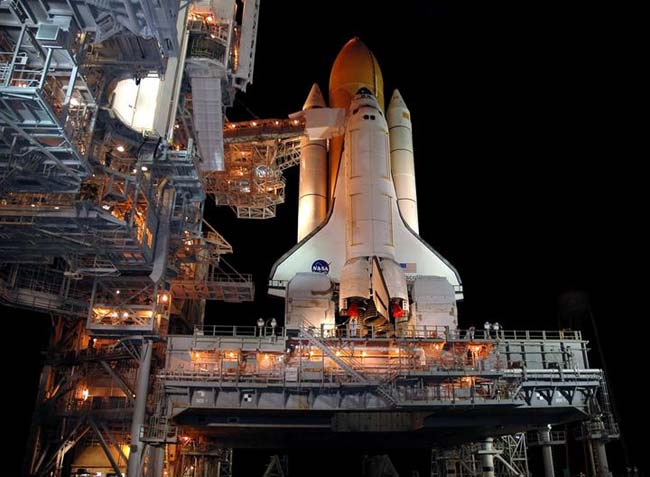Delays Predicted for NASA's Next Shuttle Launch

The launchof the space shuttle Discovery, NASA's first orbiter to fly since the Columbiaaccident, may be delayed a week to allow more time for thespace agency to prepare its paperwork, unconfirmed sources said Tuesday.
While NASAhas not yet officially announced the delay, there has been some talk aboutpushing back the launch window's opening and a statement is anticipated to bereleased later today, a shuttle worker spokesman told SPACE.com.
According to reports by MSNBC andNBC News, NASAmanagers are expected to announce Wednesday that the launch window for thespace shuttle Discovery and its STS-114 crew is now set to open on May 22. NASAofficials were previously targeting May 15 as the start of their launch windowfor Discovery's flight.
The agencyplans to hold a teleconference at 3:30 p.m. EDT (1930 GMT) today to discuss itsreturn to flight preparations.
NASAofficials were meeting Tuesday to conduct a design certification review forDiscovery's flight, which features a series of new tools and modifications toenhance shuttle safety. An independent safety panel, the Stafford-Covey Returnto Flight Task Group, has been waiting on paperwork from NASA to complete itsevaluation of the agency's effort to safely resume space shuttle launches.
NASA'sthree remaining space shuttles were grounded following the Feb. 1, 2003 loss ofthe Columbia orbiter and its STS-107 crew. Columbia broke up during reentry dueto damage sustained at launch, when a chunk of insulation foam separated fromits external tank and struck the orbiter's left wing leading edge.
Discovery'smission, commanded by veteran astronaut Eileen Collins, is a 12-day spaceflightto test a series of new tools and maneuvers designed to verify spacecraftintegrity and enhance mission safety.
Get the Space.com Newsletter
Breaking space news, the latest updates on rocket launches, skywatching events and more!
Among themost noticeable modifications are; a redesigned external tank, a new orbitalboom system tipped with lasers and a camera to scan Discovery's thermalprotection system, and a new flip-around flight maneuver during docking at theInternational Space Station (ISS) to allow on-station astronaut to photographthe orbiter's tile-covered underside.
Should NASAmiss the May-June launch window, the next opportunity opens July 13.
NASAofficials have chosen both the May-June and July launch windows because oftheir large margin in which to loft the shuttle. Flight rules instituted afterthe loss of Columbia call for daylight liftoffs, and adequate lightingconditions during key mission events, such as external tank separation andrendezvous with ISS.
After theJuly window, launch opportunities in the fall become quite slim and are limitedto days, not the weeks offered by the initial flight targets, shuttle programmanagers have said.
- Fixing NASA: Complete Coverage of the Space Shuttle Return to Flight
Join our Space Forums to keep talking space on the latest missions, night sky and more! And if you have a news tip, correction or comment, let us know at: community@space.com.

Tariq is the Editor-in-Chief of Space.com and joined the team in 2001, first as an intern and staff writer, and later as an editor. He covers human spaceflight, exploration and space science, as well as skywatching and entertainment. He became Space.com's Managing Editor in 2009 and Editor-in-Chief in 2019. Before joining Space.com, Tariq was a staff reporter for The Los Angeles Times covering education and city beats in La Habra, Fullerton and Huntington Beach. In October 2022, Tariq received the Harry Kolcum Award for excellence in space reporting from the National Space Club Florida Committee. He is also an Eagle Scout (yes, he has the Space Exploration merit badge) and went to Space Camp four times as a kid and a fifth time as an adult. He has journalism degrees from the University of Southern California and New York University. You can find Tariq at Space.com and as the co-host to the This Week In Space podcast with space historian Rod Pyle on the TWiT network. To see his latest project, you can follow Tariq on Twitter @tariqjmalik.








